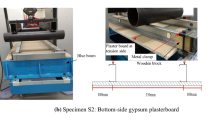Abstract
This paper reports the results of a study conducted to investigate the behaviour of steel cap plate connections. In the analysis and design, connections are characterized as either rigid or pinned and between these two extremities lies the actual behaviour of steel frame connections, which is semi-rigid. This classification is characterized by the nonlinear moment-rotation relationship which must be incorporated in the analysis. A cap plate connection is widely used in industrial steel frames for its advantages over other types of building connections, but the response of such a connection has not sufficiently been experimentally determined. In this research, the behaviour of cap plate connections was studied by testing four full-scale connections. Experimental results obtained would add valuable information to the available test data concerning steel connections since sparse data is available in the literature for this type of connection. Mathematical and numerical models were used to analyze the cap plate connection and close correlations were found between these models and the experimental results.
Similar content being viewed by others
References
Abdalla, K. M. and Chen, W. F. (1995). “Expanded database of semi-rigid steel connections.” Computer and Structures, 56(4), pp. 553–564.
AISC ASD (1989). Manual of steel construction, allowable stress design. 9th Ed., American Institute of Steel Construction, Chicago, IL.
AISC LRFD (2005). Manual of steel construction, load and resistance factor design. American Institute of Steel Construction, Chicago, IL.
Al-Jabri, K. S., Burgess, I. W., Lennon, T., and Plank R. J. (2005). “Moment rotation temperature curves for semirigid joints.” Journal of Constructional Steel Research, 61, pp. 281–303.
Allen, P., et al. (1996). Steel construction institute and British constructional steelwork association. Joints in Steel Construction, Moment Connections, London.
Arizu, S. (2007). Behaviour of partial-strength connection in semi-continuous construction for multi-storey braced steel frame using TWP sections. Ph.D Thesis, Universiti Teknologi Malaysia, Skudai, Johor, Malaysia.
Bahaari, M. R. and Sherbourne, A. N. (1996). “3D simulation of bolted connections to unstiffened columns — Part I. T-stub connection.” J. Construct. Steel Res., 40(2), pp. 169–187.
Bose, B. and Hughes, A. F. (1995). “Verifying the performance of standard ductile connections for semicontinuous steel frames.” Proc. Inst. Civ. Engrs. Structures and Buildings, 110, pp. 441–457.
Bower, A. F. (2009). Applied mechanics of solids. First Edition, CRC Press, USA.
Chen, W. F. and Kishi, N. (1989). “Semi-rigid steel beam-tocolumn connections: database and modelling.” Journal of Structural Engineering, 115(1), pp. 105–119.
Dong, Q. (1994). Microcomputer analysis of reinforced concrete flat-plate structures subjected to lateral loading. M.Sc. Thesis, The Uninersity of Manitoba, Canada.
El-Boghdadi, M. H. (1998). Elastic plastic analysis of semirigid industrial frames. Ph.D. Thesis, KFUPM, KSA.
Jones, S. W., Kirby, P. A., and Nethercot, D. A. (1983). “The analysis of frames with semi-rigid connections-A state of the art report.” Journal of Constructional Steel Research, 3(2), pp. 2–13.
Nassani, D. E. (2011). Static and dynamic behavior of frames with semi-rigid connection. Ph.D. Thesis, Aleppo University, Syria.
Nethercot, D. A. (1985). Steel beam-to-column connections-A review of test data and its applicability to the evaluation of joint behavior in the performance of steel frames. CIRIA Project Record, RP 338, London.
Salmon, C. G., Johnson, E. J., and Malhas, F. A. (2009). Steel structures, design and behavior. 5th Ed., Pearson Prentice Hall, USA.
Scerbo, J. S. (1996). Analysis of steel frames with deformable beam to column connections. M.Sc. Thesis, The University of Manitoba, Canada.
Shi, W. L., Li, G. Q., Ye, Z. M., and Xiao, R. Y. (2007). “Cyclic loading tests on composite joints with flush end plate connections.” International Journal of Steel Structures, 7(2), pp. 119–128.
Tahir, M. M. D. (2008). “Experimental tests on composite and non-composite connections using trapezoid web profiled steel sections.” International Journal of Steel Structures, 8(1), pp. 43–58.
Tahir, M. M. D., Sulaiman, A., and Saggaff, A. (2008). “Structural behaviour of trapezoidal web profiled steel beam section using partial strength connection.” Electronic Journal of Structural Engineering, 8, pp. 55–66.
Ypma, T. J. (1995). “Historical development of the Newton-Raphson method.” SIAM Rev., 37(4), pp. 531–551.
Author information
Authors and Affiliations
Corresponding author
Rights and permissions
About this article
Cite this article
Nassani, D.E. Behaviour of steel cap plate connections: Experimental tests. Int J Steel Struct 14, 649–657 (2014). https://doi.org/10.1007/s13296-014-3022-9
Received:
Accepted:
Published:
Issue Date:
DOI: https://doi.org/10.1007/s13296-014-3022-9




